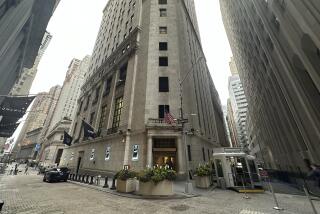Dollar Weakens on Jobless Report
- Share via
The dollar on Friday suffered its biggest one-day drop against the euro since January after a report showed a jump in the U.S. jobless rate in April, fueling concern that an economic rebound may be slower than projected.
Demand for the currency also waned as the Standard & Poor’s 500 index dropped to a six-month low this week on skepticism about the strength of the U.S. expansion.
“People’s perceptions of the U.S. are not nearly as positive as they were,” said Jonathan Clark, vice chairman of FX Concepts Inc. “The U.S. just isn’t the place to invest that it used to be.”
The U.S. currency slid 1.6% to 91.73 cents per euro, from 90.32 Thursday, and reached its lowest level since Oct. 9. It sank to 126.97 yen from 127.94, reaching the lowest point in almost two months. It was the dollar’s fifth straight weekly loss against the euro and the third against the yen.
The dollar probably will drop to at least 94 cents per euro this month, Clark said, which would be its weakest since February 2001.
International investors exiting U.S. stocks and seeking a haven amid continued tension in the Middle East are selling dollars for European currencies, principally the Swiss franc, traders said.
“You’re seeing portfolio shifts out of the U.S. and into other areas” by foreign investors, primarily toward Europe, said Peter Gerhard, head of foreign exchange at Goldman Sachs Group Inc.
Some weakening in the dollar is welcome news to U.S. exporters, who have complained that their competitiveness has diminished relative to foreign rivals as the dollar has risen in recent years. It’s still up 23% against the euro since the 12-nation currency’s debut in 1999, making U.S.-produced goods more expensive in Europe.
The dollar extended its declines Friday after a separate report showed that an index of U.S. services, the biggest part of the economy, fell in April.
Some analysts said the dollar is weakening because of concern U.S. inflation will pick up this year. Higher energy prices--crude oil has risen by about a third this year--are contributing to that concern, as is the drop in the dollar, which raises the cost of imports, they said.
“Foreigners are reluctant to buy more [U.S. securities] in this type of environment” because of concern their returns will be eroded, said Harvinder Kalirai, senior strategist at State Street Corp. in Boston.
Bloomberg News
LIN TV Shares Rise 14%
on First Day of Trading
LIN TV Corp. shares rose 14% in their first day of trading after the owner of 26 TV stations said it plans to more than quadruple the number of stations it operates.
The shares, trading under the ticker TVL, rose $3 to $25. Chief Executive Gary Chapman expects a 7% rise in sales in the first quarter and double digit revenue growth in the second, he said.
LIN TV, controlled by buyout firm Hicks, Muse, Tate & Furst Inc., also supplies sales and management services for four additional stations. LIN’s markets include Indianapolis, Buffalo, N.Y., and Austin, Texas.
Chapman said he will disclose more details on the company’s sales forecasts when LIN TV reports first-quarter results May 14. It had $271 million in sales in 2001, according to Bloomberg data.
The company raised $374 million in an initial public offering. The number of shares offered was increased to 17 million from the 14.6 million reported last month in a filing with the Securities and Exchange Commission. The shares were priced at $22 each.
The Providence, R.I.-based company said it plans to use proceeds from the stock sale to repay debts of Sunrise Television Corp., which is to be acquired in connection with the IPO.
Also Friday, Irvine-based homebuilder Standard Pacific Corp. (ticker symbol: SPF) said it is planning a 3.5-million-share stock offering priced at $34 a share. Proceeds will be used to repay debt and pay for recent acquisitions, the company said.
Standard Pacific’s stock closed at $34.25, down 45 cents, on the New York Stock Exchange.
Bloomberg News, Times Staff
Dell Buys Back Shares
at Higher Price
Dell Computer Corp. (DELL), repurchased shares in fiscal 2002 for an average price that was 74% higher than the market price, according to a regulatory filing.
The premium cost Dell about $1.27 billion during the year ended Feb. 1, when the company’s average share price was $25.38. Dell shares fell $1.10 on Friday to $24.32 after the buyback cost was reported by the New York Times.
Dell uses its repurchase program to manage the dilution of share value caused by employee stock options, spokesman T.R. Reid said.
Dell executives have said they entered the contracts when the firm’s share price was rising, reaching a high of $56.43 in March 2000.
The Austin, Texas-based company bought 68 million shares for $3 billion, or about $44.12 a share, in fiscal 2002, according to an annual report filed this week.
Dell has repurchased 940 million shares over a six-year period for an aggregate cost of $9.8 billion, or an average price of $10.43, the company said.
Bloomberg News
More to Read
Inside the business of entertainment
The Wide Shot brings you news, analysis and insights on everything from streaming wars to production — and what it all means for the future.
You may occasionally receive promotional content from the Los Angeles Times.










